 W
WCommedia dell'arte was an early form of professional theatre, originating from Italy, that was popular in Europe from the 16th to the 18th century. Commedia dell'arte was formerly called Italian comedy in English and is also known as commedia alla maschera, commedia improvviso, and commedia dell'arte all'improvviso. Commedia is a form of theatre characterized by masked "types" which began in Italy in the 16th century and was responsible for the advent of actresses and improvised performances based on sketches or scenarios. A commedia, such as The Tooth Puller, is both scripted and improvised. Characters' entrances and exits are scripted. A special characteristic of commedia dell'arte are the lazzi. A lazzo is a joke or "something foolish or witty", usually well known to the performers and to some extent a scripted routine. Another characteristic of commedia dell'arte is pantomime, which is mostly used by the character Arlecchino (Harlequin).
 W
WPietro Andolfati was an actor and troupe director, active mainly in Northern Italy, mainly of comedies. He is also known as Pietro Attore Andolfatti.
 W
WFrancesco Andreini was an Italian actor mainly of commedia dell'arte plays. He began his career playing the role of the unsophisticated love-stricken young man. Later he played the role of Capitan Spavento, a Pickwickian character of excessive fatigue
 W
WGiambattista Andreini was an Italian actor and the most important Italian playwright of the 17th century.
 W
WIsabella Andreini, also known as Isabella Da Padova, was an Italian actress and writer. Considered beautiful, elegant, and well educated, she was one of the most famous performers of her time. Isabella Andreini was a member of the Compagnia dei Comici Gelosi, an influential touring theatre company that performed for the highest social circles of Italy and France. Famous in her time, and distinguished both for her acting and her character, the role of Isabella of the commedia dell'arte was named after her.
 W
WZanetta Rosa Benozzi Balletti, known under her stage name Silvia Balletti, was an Italian actress. She was active at the Troupe de Regente of Luigi Riccoboni at the Comédie-Italienne in Paris 1716–1758. She was the star of the Italian theatre in Paris and regarded as a superior interpreter of the plays by Pierre de Marivaux. She mainly played the part of heroine in Commedia dell'arte, Silvia. Casanova belonged to her admirers.
 W
WNiccolò Barbieri was an Italian writer and actor of the commedia dell'arte theatrical genre. He was also known as Beltrame di Milano in reference to one of his most popular characters, Beltrame; this was the main character of one of Barbieri's best known plays, L'inavertito, which is known to have inspired Moliere's L'Étourdi ou les Contretemps. Besides popularizing Beltrame, Barbieri is also credited with creating another commedia dell'arte mask, Scapino.
 W
WCaterina Biancolelli (1665–1716) was an Italian actress in the commedia dell'arte style of theater. She was one of the earliest actresses to play the role of Colombina, and one of the most famous.
 W
WThe Cercle Funambulesque (1888-1898)—roughly translatable as "Friends of the Funambules"—was a Parisian theatrical society that produced pantomimes inspired by the Commedia dell'Arte, particularly by the exploits of its French Pierrot. It included among its approximately one hundred and fifty subscriber-members such notables in the arts as the novelist J.-K. Huysmans, the composer Jules Massenet, the illustrator Jules Chéret, and the actor Coquelin cadet. Among its successes was L'Enfant prodigue (1890), which was filmed twice, first in 1907, then in 1916, making history as the first European feature-length movie and the first complete stage-play on film.
 W
WEach character in Commedia dell'arte is distinctly different, and defined by their movement, actions, masks, and costumes. These costumes show their social status and background.
 W
WJean-Charles Deburau was an important French mime, the son and successor of the legendary Jean-Gaspard Deburau, who was immortalized as Baptiste the Pierrot in Marcel Carné's film Children of Paradise (1945). After his father's death in 1846, Charles kept alive his pantomimic legacy, first in Paris, at the Théâtre des Funambules, and then, beginning in the late 1850s, at theaters in Bordeaux and Marseille. He is routinely credited with founding a southern "school" of pantomime; indeed, he served as tutor to the Marseille mime Louis Rouffe, who, in turn, gave instruction to Séverin Cafferra, known simply as "Séverin". But their art was nourished by the work of other mimes, particularly of Charles's rival, Paul Legrand, and by earlier developments in nineteenth-century pantomime that were alien to the Deburaux' traditions.
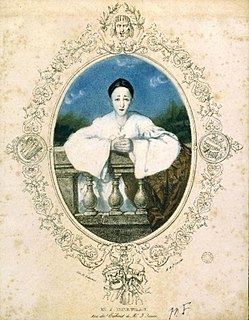 W
WJean-Gaspard Deburau, sometimes erroneously called Debureau, was a celebrated Bohemian-French mime. He performed from 1816 to the year of his death at the Théâtre des Funambules, which was immortalized in Marcel Carné's poetic-realist film Children of Paradise (1945); Deburau appears in the film as a major character. His most famous pantomimic creation was Pierrot—a character that served as the godfather of all the Pierrots of Romantic, Decadent, Symbolist, and early Modernist theater and art.
 W
WAntonio Fava is an actor, comedian, author, director, musician, mask maker and Internationally renowned Maestro of Commedia dell'arte who lives in Reggio Emilia, Italy.
 W
WTiberio Fiorilli, also spelled Fiorillo and Fiurelli was an Italian actor of commedia dell'arte known for developing the role of Scaramouche. He was especially popular in France, where he was the director of the troupe of the Comédie-Italienne, which shared with the troupe of his friend Molière at the theatre of the Petit-Bourbon, and the theatre of the Palais-Royal.
 W
WFrancesco Gabrielli (1588–1636) was an Italian actor of the commedia dell'arte. He was particularly famous as a virtuoso musician, who was an accomplished player of a dozen musical instruments. He is sometimes credited with the creation of Scapino, a musical zanni (servant) role, which he may actually have taken from Niccolò Barbieri. Gabrielli first appears as a member of the troupe of the Accesi in 1612, is later recorded as a member of the Confidenti, and in 1624 was with the Fedeli in Paris, before rejoining the Accesi.
 W
WGiovanni Gabrielli was an Italian actor of the commedia dell'arte, who performed under the name Sivello.
 W
WI Gelosi was an Italian acting troupe that performed commedia dell'arte from 1569 to 1604. Their name stems form their motto: Virtù, fama ed honor ne fèr gelosi, long thought to mean "Virtue, fame and honour made us jealous", or "We are jealous of attaining virtue, fame, and honour", signifying that such rewards could only be attained by those who sought for them jealously. Modern reevaluations have considered "zealous" as a more accurate translation over "jealous", redefining their motto to signify that, as actors, they were zealous to please.
 W
WCarlo Osvaldo Goldoni was an Italian playwright and librettist from the Republic of Venice. His works include some of Italy's most famous and best-loved plays. Audiences have admired the plays of Goldoni for their ingenious mix of wit and honesty. His plays offered his contemporaries images of themselves, often dramatizing the lives, values, and conflicts of the emerging middle classes. Though he wrote in French and Italian, his plays make rich use of the Venetian language, regional vernacular, and colloquialisms. Goldoni also wrote under the pen name and title Polisseno Fegeio, Pastor Arcade, which he claimed in his memoirs the "Arcadians of Rome" bestowed on him.
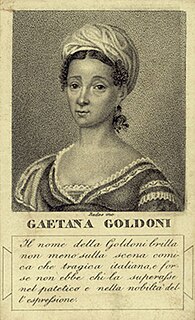 W
WGaetana Goldoni Andolfati was an actress, mainly in comedy, and active mainly in Northern Italy.
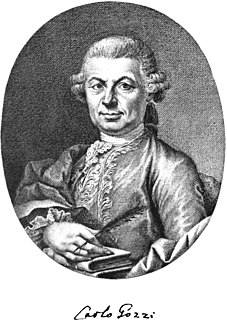 W
WCarlo, Count Gozzi was a Venetian playwright and champion of Commedia dell'arte.
 W
WHarlequinade is a British comic theatrical genre, defined by the Oxford English Dictionary as "that part of a pantomime in which the harlequin and clown play the principal parts". It developed in England between the 17th and mid-19th centuries. It was originally a slapstick adaptation or variant of the Commedia dell'arte, which originated in Italy and reached its apogee there in the 16th and 17th centuries. The story of the Harlequinade revolves around a comic incident in the lives of its five main characters: Harlequin, who loves Columbine; Columbine's greedy and foolish father Pantaloon, who tries to separate the lovers in league with the mischievous Clown; and the servant, Pierrot, usually involving chaotic chase scenes with a bumbling policeman.
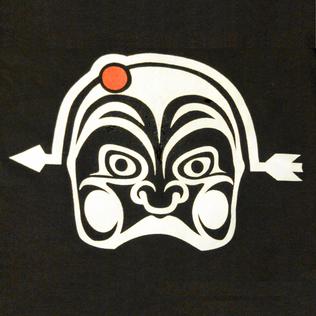 W
Wi Sebastiani is a Commedia dell'Arte theatre troupe formed in 1990 by Jeff Hatalsky. To the present day, i Sebastiani has performed for thousands of fans across the United States and Canada. The company has travelled as far as Montreal to the north, Miami to the south, and Texas to the west, performing more than 100 different improvisational scenarios.
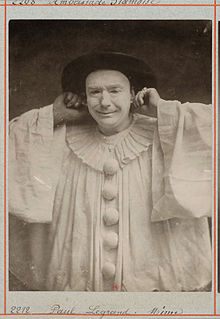 W
WPaul Legrand, born Charles-Dominique-Martin Legrand, was a highly regarded and influential French mime who turned the Pierrot of his predecessor, Jean-Gaspard Deburau, into the tearful, sentimental character that is most familiar to post-19th-century admirers of the figure. He was the first of the Parisian mimes of his era to take his art abroad—to London, in late 1847, for a holiday engagement at the Adelphi—and, after triumphs in mid-century Paris at the Folies-Nouvelles, he entertained audiences in Cairo and Rio de Janeiro. In the last years of the century, he was a member of the Cercle Funambulesque, a theatrical society that promoted work, especially pantomime, inspired by the Commedia dell'Arte, past and present. The year of his death coincided with the last year of the Cercle's existence.
 W
WCarlo Maria Maggi was an Italian scholar, writer and poet. Despite being an Accademia della Crusca affiliate, he gained his fame as an author of "dialectal" works in Milanese language, for which he is considered the father of Milanese literature. Maggi's work was a major inspiration source for later Milanese scholars such as Carlo Porta and Giuseppe Parini.
 W
WPagliacci is an Italian opera in a prologue and two acts, with music and libretto by Ruggero Leoncavallo. It is the composer's only opera that is still widely performed. Opera companies have frequently staged Pagliacci with Cavalleria rusticana by Pietro Mascagni, a double bill known colloquially as "Cav and Pag".
 W
WPedrolino is a primo zanni, or comic servant, of the Commedia dell'Arte; the name is a hypocorism of Pedro (Peter), via the suffix -lino. The character made its first appearance in the last quarter of the 16th century, apparently as the invention of the actor with whom the role was to be long identified, Giovanni Pellesini. Contemporary illustrations suggest that his white blouse and trousers constituted "a variant of the typical zanni suit", and his Bergamasque dialect marked him as a member of the "low" rustic class. But if his costume and social station were without distinction, his dramatic role was certainly not: as a multifaceted "first" zanni, his character was—and still is—rich in comic incongruities.
 W
WPierrot is a stock character of pantomime and commedia dell'arte whose origins are in the late seventeenth-century Italian troupe of players performing in Paris and known as the Comédie-Italienne; the name is a diminutive of Pierre (Peter), via the suffix -ot. His character in contemporary popular culture—in poetry, fiction, and the visual arts, as well as works for the stage, screen, and concert hall—is that of the sad clown, often pining for love of Columbine, who usually breaks his heart and leaves him for Harlequin. Performing unmasked, with a whitened face, he wears a loose white blouse with large buttons and wide white pantaloons. Sometimes he appears with a frilled collaret and a hat, usually with a close-fitting crown and wide round brim, more rarely with a conical shape like a dunce's cap. But most frequently, since his reincarnation under Jean-Gaspard Deburau, he wears neither collar nor hat, only a black skullcap. The defining characteristic of Pierrot is his naïveté: he is seen as a fool, often the butt of pranks, yet nonetheless trusting.
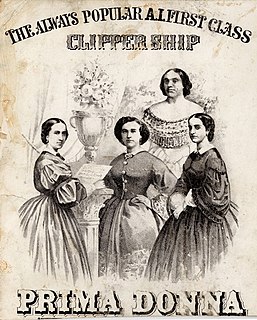 W
WIn opera or commedia dell'arte, a prima donna is the leading female singer in the company, the person to whom the prime roles would be given.
 W
WLuigi Riccoboni was an Italian actor and writer on theatre, who was director of the Comédie-Italienne in Paris from 1716 to 1731. In France he was known as Louis Riccoboni and his stage name was Lélio.
 W
WJean-François-Maurice-Arnauld Dudevant, known as Baron Dudevant but better known by the pseudonym Maurice Sand, was a French writer, artist and entomologist. He studied art under Eugène Delacroix and also experimented in various other subjects, including geology and biology.
 W
WThere is evidence of indoor and outdoor stages used for Commedia dell'Arte with a variation of scenic design. While we know for a fact that Commedia dell'Arte Troupes did perform in indoor spaces, there is no real evidence of use for outdoor spaces aside from depictions of various artists.
 W
WTabarin was the street name assumed by the most famous of the Parisian street charlatans, Anthoine Girard, who amused his audiences in the Place Dauphine by farcical dialogue with his brother Philippe, with whom he reaped a golden harvest by the sale of quack medicines for several years after 1618. Street theatre was popular theatre, on an improvised stage with a curtain backdrop, to the music of a hurdy-gurdy and a set of viols. More formal contemporary performances were confined to the royal court or to the Hotel de Bourgogne, overseen by the medieval guild that had the monopoly of theatrical performances in Paris.
 W
WAdriano Valerini was an Italian actor of Commedia dell'arte, active in Northern Italy.
 W
WSignora Violante (1682–1741) was a rope-dancer, acrobat, commedia dell'arte actor and theatre company manager.